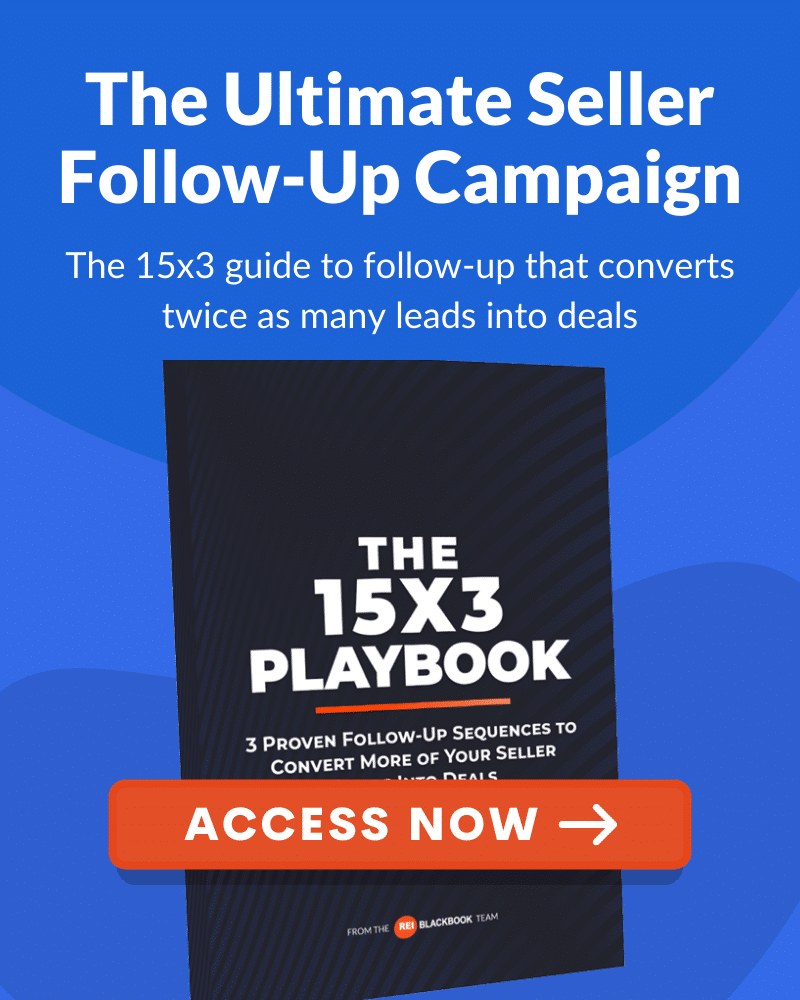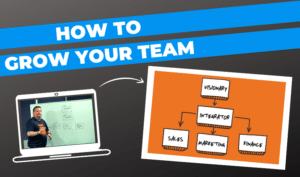Supercharge Your Follow Up Using These Real Estate Investing Tips
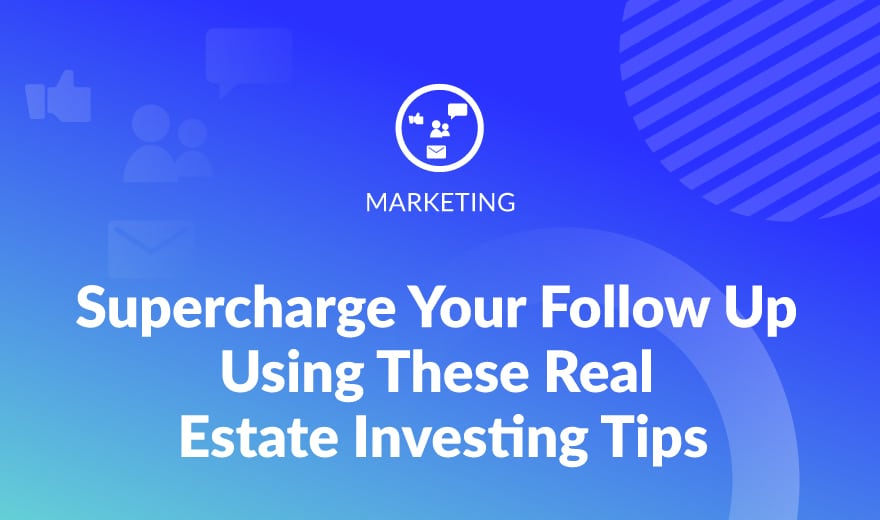
As a real estate investor fresh leads are the lifeblood of your business.
You must have a predictable and reliable system for generating new leads every month if you want to build a successful business.
In this article you will learn real estate investing tips to help you build the fundamental framework every successful real estate investing business is built on.
Without it, it’s very tough (if not impossible) to build a sustainable business.
Before we dive into the tips everything we will cover in this article is also covered in the training we hosted on Monday.
You can watch the replay of the training below.
As mentioned already, fresh leads are crucial to keep your business going.
And the follow up you have in place for those leads is just as important.
We are going to show you how to automate your follow up so you can close more deals from the leads that you're already generating.
We're going to talk about why that's important and the opportunity that you have as a real estate investor and a small business owner, when you get your follow up processes automated.
We're going to talk about the importance of and how to install predictable processes into your business.
Think about how a factory works, for example the Tesla Plant.

Every single screw that's supposed to be screwed in gets screwed in just the way it's supposed to, the doors get installed the same way every time, and the trunk gets installed the same way every time.
There's not a motor engine in a Tesla, but if this was a Ford plant the motor engine would get installed the same way every single time.
The process of building the car is predictable because it’s done the same way each time.
So, how do you install predictable processes in your business so you can make sure that when leads come in, that they're being handled the same way every single time?
These processes will ensure that leads don't fall through the cracks because not everyone is going to be ready to sell their house when they give you a call.
Let's take a look at some numbers.
The goal here is we want you to be able to focus on your hot prospects and let your follow up campaigns do the rest. This will allow you to focus the majority of your time on talking to people that are in fact ready to sell their house today.
Then you can let the system warm up the rest of your leads and prospects and in three months or six months, they will be hot leads because they'll be ready to talk to you and you'll be there, ready and waiting.
We’ve been working with real estate investors for a long time and we’ve found that the majority of people that respond to your marketing, come to your website, or see your bandit sign and maybe give you a call, they're not ready to sell their house.
The majority of people are not ready to sell their house right away. It's just like any other type of transaction that you would engage in.
You typically are going to go out and you're probably going to call a couple of different companies. You're going to get online and do some research.
You're not usually going to just wake up and say, “I need to sell my house.” Or, “I need to refinance my house.” Or, “I need to buy a new car.” Especially if it's a bigger decision.
Selling a house is a big decision. There's a lot of money at stake.
So, what we found is about 3%-5% (these are rough averages) of people that respond to your marketing, depending on the type of list that you're marketing to or the type of marketing you're doing, are going to be ready to sell their house.
Maybe you just caught them at the right time. They saw your bandit sign, or they heard your radio ad, or they got your postcard just at the right time, and they pick up the phone and call you, you book an appointment that day, you get a contract signed within a week.
When that happens, it's amazing, but it's really, really tough to build a predictable business or a sustainable business using those types of leads, because they're usually pretty expensive to generate.
But this is where the majority of investors are hanging out. Everybody wants to talk to the hot leads.
The problem is there's just not that many of them at any given time. And usually the bigger investors in your market that are spending $15,000 to $30,000 a month on marketing, are ready and waiting, and they're there. That's why they're spending so much money on marketing because they just want to talk to the hot leads.
They don't want to have to follow up with people. The problem with that is, to compete with that, you have to have a huge marketing budget.
And if you stop and you think about it, if 5% of people are ready to sell their house right away, what happens to the rest? So, 80% of that same list, people that respond to your marketing, people that go to your website, 80% of them are going to sell their house at some point, but it might take three, six, nine, even 12 months for them to do that.
So, while everybody else is hanging out in the 5%, only marketing to super hot leads, the 80% is where the real money is made. Especially if you're already doing the hard work to generate the leads, you're just talking to people that aren't quite ready to sell right away.
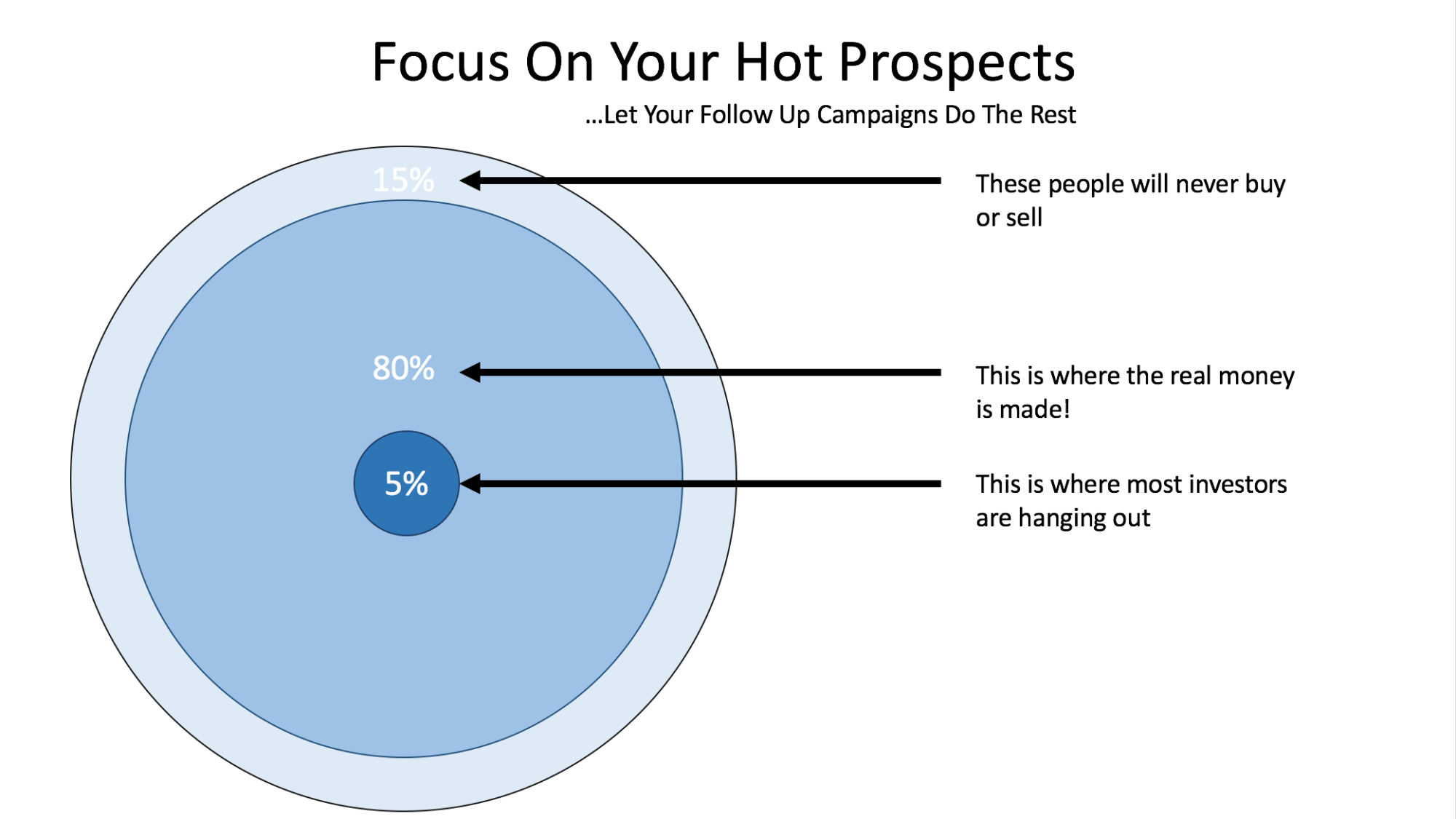
And then of course, there's going to be a certain percentage of people that are just never going to buy or sell. And that's fine. We can mark them as truly dead leads.
Maybe they call you and they say, “Hey, the house is already sold.” Or, “Hey, I'm not selling my house. Stop sending me mail.” You can just take them off your list and you can forget about them. There's no reason to try to sell the people that are completely unsellable.
But imagine having an automated sales team, that is sitting there every single day, following up with that 80% of people that picked up the phone and called into your business, but they just weren't ready to sell today.
Imagine what type of difference that would make in your business if you were able to have three human beings sitting in your office every day just calling leads.
It'd be very expensive, and you then have to manage those people. A lot of investors we’ve talked to, don't want to build a team. They want to do this by themselves. If you do want to build a team having these systems in place is going to make it a lot easier to add people to your business.
We have a framework that we teach here at REI BlackBook, and call it The Seller Acquisition Workflow Map.
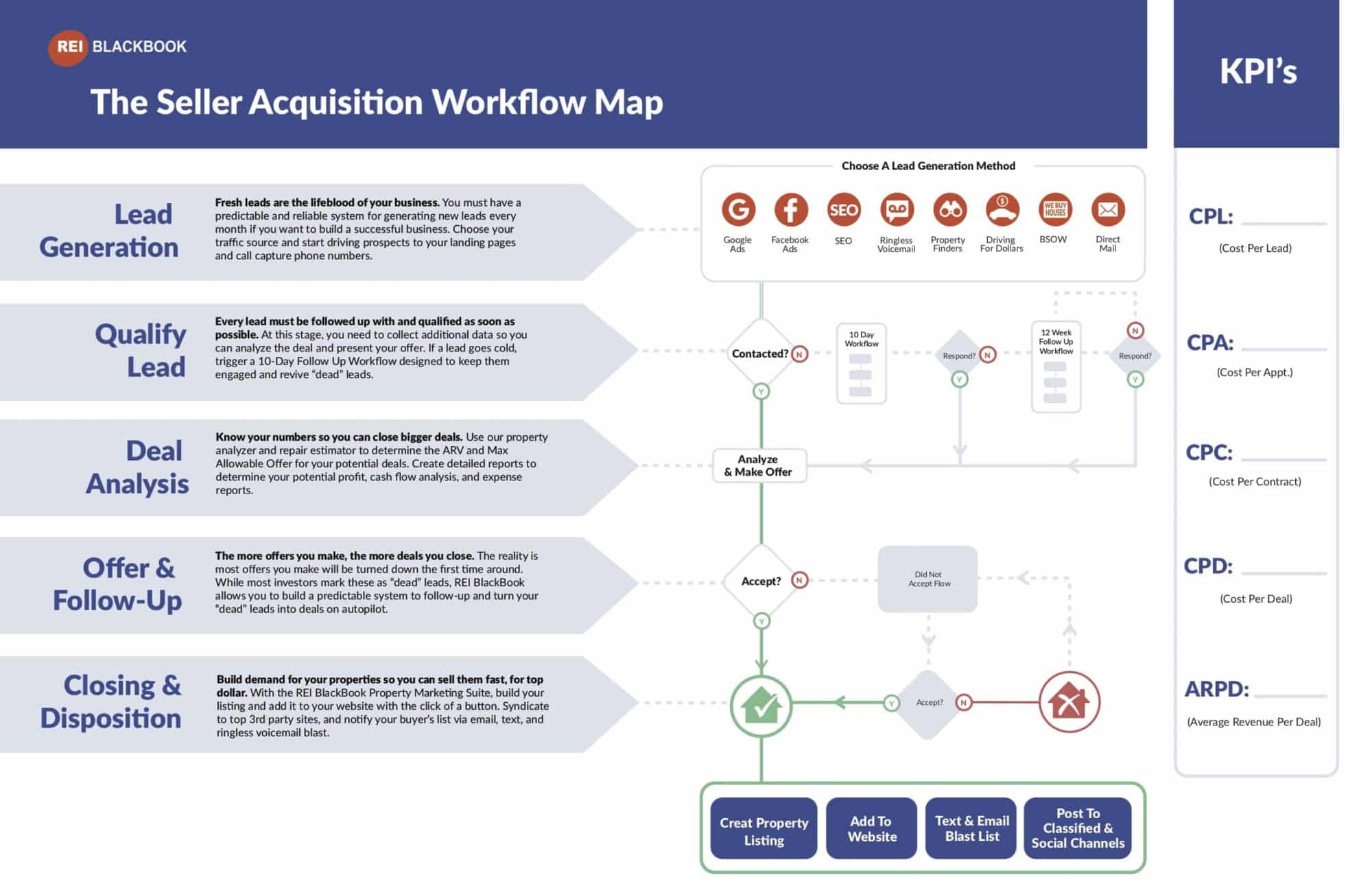
This map acts as your automated sales team. It's like having a team of sales reps, just calling your leads every single day.
There's five stages to a typical sales process.
- Lead Generation
- Lead Qualification
- Deal Analysis
- Offer & Follow Up
- Closing & Disposition
So, the typical sales cycle will look something like this.
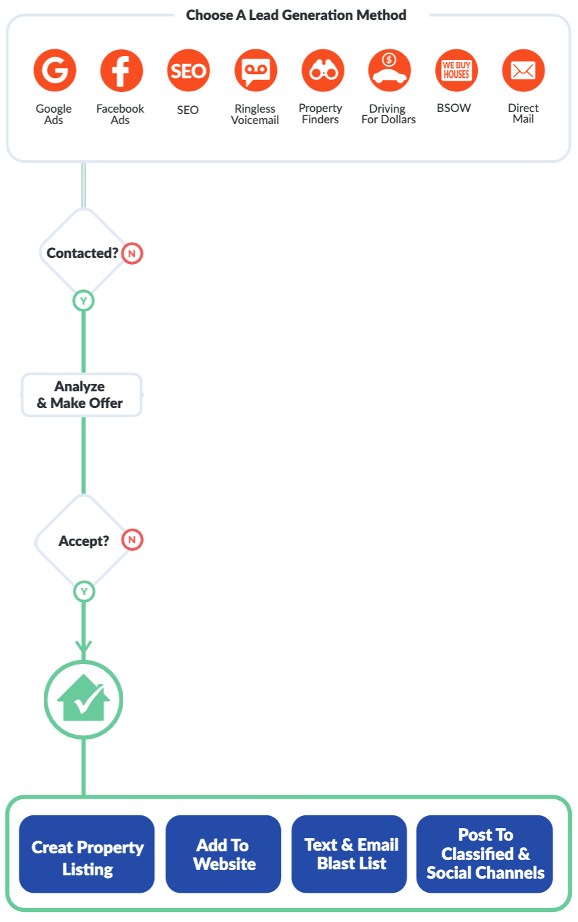
You market to generate leads. Whether it be bandit signs, direct mail, maybe you're doing some sort of Google ads or Facebook ads, or some sort of online marketing, whatever strategy you decide to use you have to market to get leads.
Then you have to get in contact with those leads somehow. If they're calling into your business, you can answer the phone. If they go and they fill out a form on your website, hopefully you're able to respond to the submission within the first 5-10 minutes by picking up the phone and giving them a call right away.
You want to be able to contact that person. You have to talk to them.
Assuming that you do talk to them, you're going to have to analyze the deal and make an offer.
So we're going to assume that everything kind of just goes perfect. This is one of those amazing one call closes where they're just ready to do business. This is the 3%-5% of leads that want to close today.
After you analyze and make the offer, do they accept the offer? Assuming that they do, you then close on the property and then you decide how you're going to disposition that property.
You dispose of the property, and now everything is done and you can move on to the next deal.
Now, the problem is a lot of people fall out and you can see that there's yes or no paths in the process map.
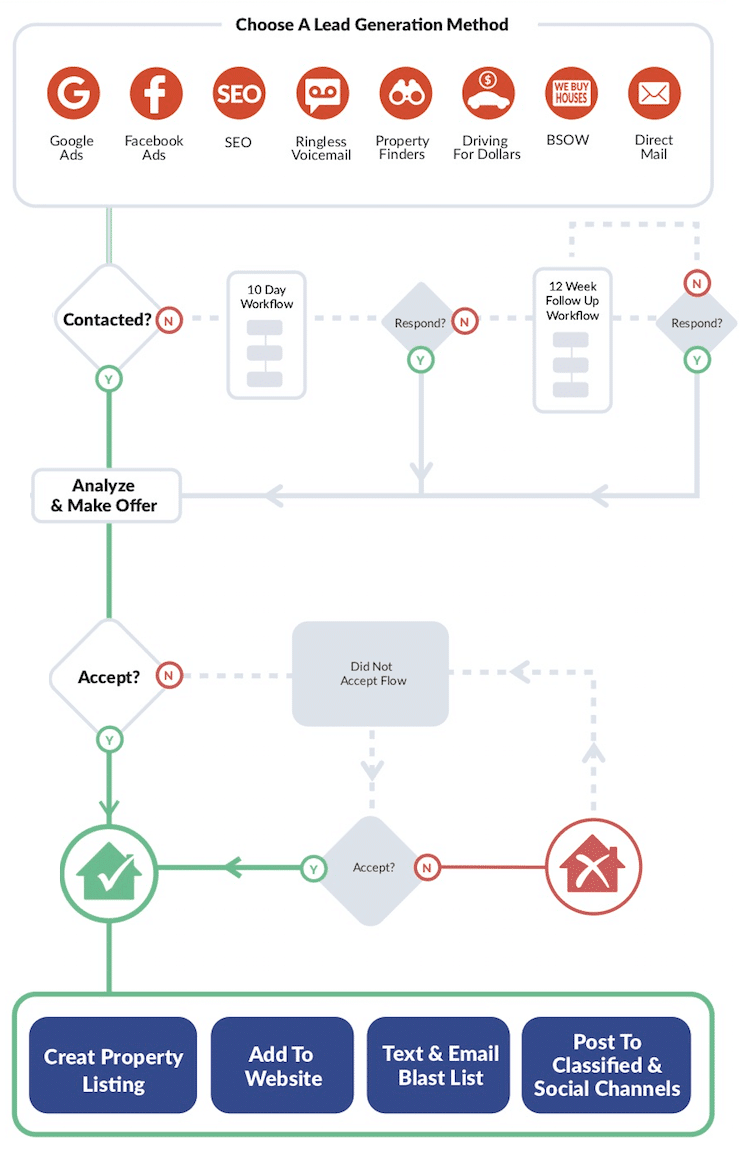
People will fall out at every stage.
And there's an opportunity here to implement a followup plan, to plug your leaky sales bucket, if you will, every time that there's one of these decision diamonds in this process map.
So, why is this so important?
Why is it so important to focus on people that tell you no at each stage of the sales cycle?
Well, if we take a look and we say you're generating 100 leads, so whether this be 100 leads a month or 100 leads a quarter, 100 leads a year, it doesn't really matter what the time frame is, but you're generating 100 leads.
You talked to about 60 of those leads. So you get them on the phone, talk to them.
Out of those, you book about 10 appointments.
And then you're able to close two deals.
What we want you to realize is that, no matter how much money it costs to generate these 100 leads or the time and effort that was spent to generate these 100 leads, you have their information.
You probably have their property address. You probably have their phone number, but for whatever reason, they just went cold on you.
They're not interested in selling at that point in time.
So, why is it so important to focus on increasing your conversion?
Why is it so important to focus on the leads you generated last month and three months ago and even last year?Well, if we look at the numbers we used, right now, you have a 2% conversion rate based on generating 100 leads, booking 10 appointments, and closing two deals.
So two deals out of 100 leads, that's a 2% conversion rate if we talk leads to deals.
And let's say you’re wholesaling and your average wholesale fee is $8,000, so for two closed deals, that’s $16,000.
What if you could follow up with the other 8 people you’ve talked to who booked an appointment, but for whatever reason they told you no. Or what if you could follow up with the other 90 that didn't book an appointment.
And by follow up you could get a couple more of those people to book appointments, so you can close a couple more deals and you wouldn't have to spend any more money to do it.
So, what if you could just bump your conversion rate from 2% to 4%, what would that do to your bottom line?
Well, that would help you then book 20 appointments and ultimately it would help you close two extra deals.
So four deals now instead of two.
Which means now you're making $32,000 from those same 100 leads instead of 16.
Use These Real Estate Investing Tips To Close More Deals From The Leads You’re Already Generating
1. Implement An Engagement Campaign
So let's take a look at what that might look like if you implemented some of these follow up campaigns in your business.
The first point of failure in any type of sales organization, or any type of sales process is that first initial contact.
Somebody comes to your website, fills out a form, somebody calls into your business, do you answer, do you not? Let's assume that you're not able to get a hold of them because a lot of these leads, you're not going to be able to get a hold of right away.
What happens?
What we encourage you to do is put them on a 10 day follow up campaign.
And this is a relatively aggressive campaign. And we don't mean with the language. We just mean with the frequency of the followup.
So, every single day, they're at least going to receive one piece of communication from you, it's going to either be a text message, a ringless voicemail, or an email. Or you can call them again.
Throughout those 10 days, they're going to get about 7 to 10 points of contact because some days you might actually hit them with an email and a text message. And all of this is automated.
Let's say that after the third or fourth day, somebody actually responds to the communication you’ve sent out.
What happens?
Now they are back going down the green line, and everything is back on track for the sales cycle.
You analyze the deal, you make an offer, and now you've got another hot prospect. Which is great!
So even if all you did was implement this 10 day follow up campaign, you would be doing much better than the majority of investors in your market. And you would instantly be able to close more deals than a lot of your competition.
And definitely, you'd be able to close more deals than you currently are from the leads you're already generating, just because you're following up.
2. Implement A Revival Campaign
But, what happens after those 10 days? What if they don't reply?
Well, now you can create a longer term drip campaign, and you're not going to reach out to them every day, because that would be annoying.
So the farther away you get from that initial point of contact, the more spread out your follow up becomes.
Now you might send them a text message or ringless voicemail every two weeks or so, and the whole purpose of this and what you say in the text message or the email or the ringless voicemail, is very casual.
You're just trying to get a response.
You don't need to send them an email with 1,000 words in it.
It's just, “Hey, it's been awhile since you contacted us about selling your house. Just wanted to see if you're still interested. We're still buying properties in your area. Shoot me a reply if you want to hop on a call.”
So now you're going to have a lot of people that are just sitting in this three month followup. And what happens is, if they don't reply after three months, it just repeats itself, and the language in these follow up campaigns are pretty evergreen.
You're not going to reference any dates or timeframes. You're just going to say, “Hey just checking back, just wanted to see if you're still interested in selling your house.”
It's just a little reminder and all you're trying to get them to do is just reply.
Again, once they reply you can keep moving through the sales cycle. You can analyze deals, and make offers.
3. Implement A Resubmit Offer Campaign
After the offer is made you're at your next point of failure, if you will, in the sales cycle.
What happens if they don't accept?
You get a no, and what most investors do is mark that lead dead and move on to the next one because they weren’t interested in the offer the first time.
However, you’re not most investors, so you create another simple follow up campaign. All this follow up campaign really does is once a quarter, so once every three months, it's going to send them an email and a text message.
And all it's going to say is, “Hey, I know it's been a while since we last chatted. Just wanted to see if your property at 123 Main Street is still for sale. We're still interested in buying in your area.”
This campaign will also send you a reminder to go research the property at the County Assessor's website and see if it has been sold.
The reason we actually started teaching this last follow up campaign is one of our users, Darren Buttram, he ended up closing an extra 30 plus deals a couple of years back, just from this one campaign. So, these were people that he talked to. He went on appointments. He made offers, and they just said, no. They said, “Hey, we're looking for more money. We're not going to sell our house to you.”
So, every three months, the system would automatically send them a reminder, and he would go research the property at the County Assessor's website.
At that point, one of two things would happen. Number one, he'd see that the property was still available and he would send them an email with a letter of intent attached with the offer on it.
If the property had been sold, he could see who the property was sold to and how much the property was sold for.
So he can see how off he was on his offer. So either way, he's able to use that information. If the property wasn't sold, he follows up. If the property was sold, he just makes a note and says, “Hey, I was off by $10,000.”
Typically, that's going to be an investor who buys. So he can then add that person to his cash buyers list, which is pretty cool as well.
So, this right here, really, is where the money in this business is made. And if you can implement even one of these in your business, it's going to help you close more deals from the leads that you're already generating.
If you can slowly implement all three, then you're going to be light years ahead of the competitors in your market. Because this really acts like an automated sales team, every single day, especially as you fill this up.
If you do this for three, four, five, six months, all of a sudden you're going to have 60, 70, 80 leads at any given time that are in your followup campaigns.
And they just slowly start bubbling up to the surface and people will start to reply to your text messages. They'll start to reply to your emails because something happens.
If you've been in this business long enough, you know that somebody will just call you out of the blue because they held onto your postcard and they call you 12 months later.
That's probably being more lucky than being good. It's nice to be lucky, but if you can engineer luck, that's even better.
If that prospect, instead of just holding onto your postcard, receives a text message from you, six months from now, and it just so happens to be the right time and they reply to that text message, that's predictable.
So, every single month you're going to get people that are replying to your follow up from three to six months prior.
So, how do you actually do this?
How do you actually build it, so it’s implemented in your business?
This is where a software, like REI BlackBook, will help you.
In the training Josh did on Monday he walks you through how to use workflows to get this follow up set up in your business using REI BlackBook.
If you aren’t familiar with workflows they are a predefined series of actions that you design for new leads or existing contacts to go through at certain stages of your sales cycle.
You can learn more about workflows in the blog post The REI BlackBook Workflow Builder: A Beginner’s Guide.
These three follow up campaigns are the basis of the fundamental framework your real estate investing business should be built on to ensure you have a sustainable business.
This follow up will make sure you have new leads coming in every single month.
Using the Seller Acquisition Map you will supercharge your follow up, so download it today!
What You Should Do Now:
- Get started with REI Blackbook for FREE: Get 14 days FREE access to our software and start converting more leads into deals.
- If you'd like to learn the exact strategies our power users are implementing to generate motivated seller leads consistently, check out our Motivated Seller Guide.
- If you'd like to learn how our team can build out your REI Blackbook system FOR you, head to our implementation page.
- If you know another real estate investor who'd enjoy reading this page, share it with them via email, Linkedin, Twitter or Facebook.
Recent Blog Posts
Get Started with REI BlackBook Today
Get started today and get 14 days free access
Without REI BlackBook we would not have gotten as far as we have as fast as we have. It is an invaluable swiss army knife for our business.
Andy Wright
Mountain Shamrock Properties

